I've a Widget, which wants to display Images with QLabel and QCheckBox. 4 classes are created each contains some information to be put on the final screen.
Class Grid align and grid images, text and checkboxes.
After script running get current screen. No images appear in present widget.
Where are images?
Desired screen
The code
import sys, os
from PyQt5 import QtCore, QtGui, QtWidgets
iconroot = os.path.dirname(__file__)
class ImageWidget(QtWidgets.QWidget):
def __init__(self, parent=None):
super(ImageWidget, self).__init__(parent)
self.hlay = QtWidgets.QHBoxLayout(self)
buckling_ilabel = QtWidgets.QLabel(self)
pixmap = QtGui.QPixmap(os.path.join(iconroot, "images/fixed-fixed.png"))
buckling_ilabel.resize(150, 150)
buckling_ilabel.setPixmap(pixmap.scaled(buckling_ilabel.size(), QtCore.Qt.KeepAspectRatio))
self.hlay.addWidget(buckling_ilabel)
buckling_blabel = QtWidgets.QLabel(self)
pixmap = QtGui.QPixmap(os.path.join(iconroot, "images/pinned-pinned.png"))
buckling_blabel.resize(150, 150)
buckling_blabel.setPixmap(pixmap.scaled(buckling_blabel.size(), QtCore.Qt.KeepAspectRatio))
self.hlay.addWidget(buckling_blabel)
buckling_clabel = QtWidgets.QLabel(self)
pixmap = QtGui.QPixmap(os.path.join(iconroot, "images/fixed-free.png"))
buckling_clabel.resize(150, 150)
buckling_clabel.setPixmap(pixmap.scaled(buckling_clabel.size(), QtCore.Qt.KeepAspectRatio))
self.hlay.addWidget(buckling_clabel)
buckling_dlabel = QtWidgets.QLabel(self)
pixmap = QtGui.QPixmap(os.path.join(iconroot, "images/fixed-pinned.png"))
buckling_dlabel.resize(150, 150)
buckling_dlabel.setPixmap(pixmap.scaled(buckling_dlabel.size(), QtCore.Qt.KeepAspectRatio))
self.hlay.addWidget(buckling_dlabel)
self.setLayout(self.hlay)
class EffLengthInfo(QtWidgets.QWidget):
def __init__(self, parent=None):
super(EffLengthInfo, self).__init__(parent)
ilabel = QtWidgets.QLabel('Ley = 1.0 L\nLec = 1.0 L')
blabel = QtWidgets.QLabel('Ley = 0.699 L\nLec = 0.699 L')
clabel = QtWidgets.QLabel('Ley = 2.0 L\nLec = 2.0 L')
dlabel = QtWidgets.QLabel('Ley = 0.5 L\nLec = 0.5 L')
self.ilay = QtWidgets.QHBoxLayout()
self.ilay.addWidget(ilabel)
self.ilay.addWidget(blabel)
self.ilay.addWidget(clabel)
self.ilay.addWidget(dlabel)
class CheckInfo(QtWidgets.QWidget):
def __init__(self, parent=None):
super(CheckInfo, self).__init__(parent)
icheck = QtWidgets.QCheckBox()
bcheck = QtWidgets.QCheckBox()
ccheck = QtWidgets.QCheckBox()
dcheck = QtWidgets.QCheckBox()
self.checklay = QtWidgets.QHBoxLayout()
self.checklay.addWidget(icheck, alignment=QtCore.Qt.AlignCenter)
self.checklay.addWidget(bcheck, alignment=QtCore.Qt.AlignCenter)
self.checklay.addWidget(ccheck, alignment=QtCore.Qt.AlignCenter)
self.checklay.addWidget(dcheck, alignment=QtCore.Qt.AlignCenter)
class Grid(QtWidgets.QWidget):
def __init__(self, parent=None):
super(Grid, self).__init__(parent)
self.imagewidget = ImageWidget()
self.efflengthinfo = EffLengthInfo()
self.checkinfo = CheckInfo()
vlay = QtWidgets.QVBoxLayout(self)
vlay.addLayout(self.imagewidget.hlay)
vlay.addLayout(self.efflengthinfo.ilay)
vlay.addLayout(self.checkinfo.checklay)
self.setLayout(vlay)
if __name__ == '__main__':
app = QtWidgets.QApplication(sys.argv)
im = Grid()
im.show()
sys.exit(app.exec_())


